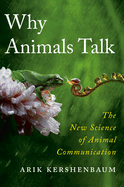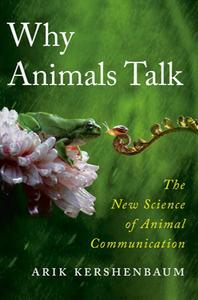
 Zoologist and Cambridge lecturer Arik Kershenbaum (The Zoologist's Guide to the Galaxy) examines the conversation methods of a handful of fascinating species in his thought-provoking popular science book Why Animals Talk: The New Science of Animal Communication. Kershenbaum synthesizes historic thought, original research, and his own contagious passion for the subject not to answer whether animals have language like humans but to reveal how and why they use the astounding communication methods they do have.
Zoologist and Cambridge lecturer Arik Kershenbaum (The Zoologist's Guide to the Galaxy) examines the conversation methods of a handful of fascinating species in his thought-provoking popular science book Why Animals Talk: The New Science of Animal Communication. Kershenbaum synthesizes historic thought, original research, and his own contagious passion for the subject not to answer whether animals have language like humans but to reveal how and why they use the astounding communication methods they do have.
Wolves howl to contact pack members across great distances, dolphins chatter constantly in clicks and whistles, and parrots can learn to speak in human voices. Humans have wondered for thousands of years what animals say to one another, but Kershenbaum encourages the reader to wonder instead why they communicate with each other in the ways they do. Along the way, he investigates the question of whether any animal has a language in the same way humans do, as well as whether scientists could ever translate animal sounds thoroughly enough to have a conversation across the divide of the species. Spoiler alert: Kershenbaum believes the evidence to date supports neither possibility, but he also considers animal-speak to be deeply fascinating despite the unlikelihood of developing a dolphin-to-human dictionary. As he says of chimpanzees, "No matter how similar to us, their communication is not like ours--it's precisely like theirs. As it should be."
His enthusiasm for his subjects is captivating: he takes the reader into the jungle where gibbons sing, under the sea to study the name-like signature whistles that dolphins use to address each other, and into rock colonies of hyraxes, a tiny relative of elephants, where dominant males use complex songs to ward off competition for female attention. Readers may not hear the sounds he describes, but they can still experience them through Kershenbaum's inclusion of spectograms, visual representations of sounds that demonstrate the difference between dolphins' personal whistles or a hyrax's snort versus its tweet or chuck.
Readers willing to let go of human exceptionalism and look at the world through the lens of animals' interactions with their environments and each other will find a rewarding exploration of communication and its impact on survival. Kershenbaum is open about the challenges facing researchers and the resulting limitations of their conclusions, acknowledging that science is merely on the frontier of this subject. This accessible survey proves animals have much to teach humans about communication if humans are willing to listen. --Jaclyn Fulwood, blogger at Infinite Reads
Shelf Talker: This engaging, accessible popular science book explores why and how animal communication methods work.

